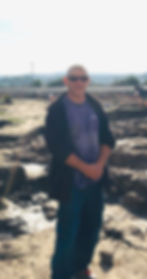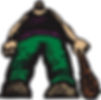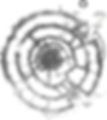In part one of our series we collected and compiled lots of interesting information on Galgal Refaim / Rujm el-Hiri. Various studies have been published, many theories are circulating about who, why and how this place was built. There are more questions than answers about this prehistoric megalithic monument, but we bring you insight from Yitzhak Paz, senior researcher at the Israel Antiquities Authority.

It's impossible to discuss this site without first analyzing the name, especially the Hebrew one, since it's loaded with mystery and biblical history. Refaim in Gilgal /Galgal Refaim, (Wheel of giants/Circle of Giants) comes from the ancient race of biblical giants, spelled Rephaim. Paz explains this reference.
"Refaim means giants. In the bible there are giants that are known as Rephaim. They are not ghosts. Today we translate ghosts as ruach refaim, but it's not this," he said.

"It was said that only giants can build this type of monument, and it's known from the bible also that Og, King of Bashan, was a giant. It's interesting that large dolmens found in Germany are called giant beds in translation from German," Paz said.
According to Deuteronomy (3:11), Og is not only mentioned as King of Bashan, and the last of the Rephaim, but the size of his bed is listed in biblical measurements that convert to 13 feet, 6 inches long x 6 feet wide.
"For only Og, king of Bashan, was left from the remnant of the Rephaim. His bedstead was a bedstead of iron; is it not in Rabbah of the children of Ammon? Nine cubits was its length, and four cubits its breadth, according to the cubit of a man."
As for the name Rujm el-Hiri: "Rujm is a large pile of stones and Hiri is a wild cat. So it's something that is connected to a wild cat. I don't why, but this is the Arabic name," explained Paz.
Drone view of Rujm el-Hiri or Galgal (Gilgal) Refaim. (Credit: Griffin-Aerial Imaging/Shutterstock)
What exactly is this site?
It's been widely documented that this megalithic monument is composed of concentric circles that surround a tomb, with the outer circle about 156 meters in diameter, and built using over 40,000 tons of basalt. It was literally hiding in plain sight, undiscovered for thousands of years because its pattern is not visible from the ground.
"This is a very unique site because there is nothing similar in our region, maybe in the whole world, but if I'm concentrating on the Levant, it is completely unique. The fact that it's made of almost complete circles in which the outer diameter of the outer circle is about 156 meters so it's very unique. The whole alignment is very unique and the fact that it was only discovered during an aerial survey after the Six-Day-War, it is so impressive that it can't be estimated at ground level," explained. Paz

Excavations led to more mystery
A fascinating fact is that archaeologists not only have different opinions about when the site was created, but even if the site itself was built together as one monument, or if the tomb and the circles were created at different periods in history. With very little archaeological finds, dating the site has created room for conflicting theories.
The most recent excavation was carried out by Michael Freikman from the Hebrew University, and he attributes the site to the Chalcolithic Period, or somewhere between the Chalcolithic Period and the Early Bronze Age, Paz said. What's interesting is that others look at the monument as two separate time periods. Paz said that some believe the tomb can be dated to the Late Bronze Age, yet others believe the entire monument is from the Late Bronze Age.
"The first excavation was conducted by professor Moshe Kochavi and his team in the scope of the Land of Geshur project [the project focused on the Southern Golan Heights]. It was conducted in the early 90s by Yoni Mizrachi and it was the first time they discovered that the inner pile of stones in the circle of the monument is actually a grave--a passage grave," Paz explained. "They found several shards, some jewelry and a few arrowheads but I don't think that the finds in the tomb can be dated because they probably reflect reuse of the tomb and very scanty material was found, almost no pottery almost no other finds, so it's very hard to date the monument," he explained.
Paz believes, however, that the site was built during the Early Bronze Age
"The team from the Land of Geshur Project, including me, tend to date the whole monument to the Early Bronze Age, where it is probably one site that combines into a large settlement pattern during the Early Bronze Age, where you have fortified settlements and towns."
Paz said that he thinks the entire monument was built between the 4th and 3rd Millennium BC, during the Early Bronze Age, based on the history of the region.
"If you take the history of the Golan, the Early Bronze Age is one of the most important periods in which the Golan was inhabited in which you had urban culture, so we tend to ascribe this monument to the Early Bronze Age."
Purpose of the site is full of theories
Ritual aspects
There is no way to know exactly if the site was built specifically for ritual purposes, but it's considered to be one theory.
"There is a possibility that the whole monument was created for ritual aspects," said Paz.
Strategic alignments
"There is a theory that it is some kind of huge calendar that is connected with agricultural behavior during the Early Bronze Age, because the alignment of the radial walls inside the monument are aligned with the astral constellations," explained Paz.
"What Aveni and Mizrachi wrote in the Journal of Field Archaeology, they stressed there that the alignment is connected with the radial walls inside the monument, not necessarily the entrances and not necessarily the concentric wall. They align with the constellations that are known and have some importance to agricultural times, so it was some kind of way for the agricultural inhabitants of the Golan to know when to start to sew seeds," he explained.
Paz said although it is believed that the radial walls are connected to astral phenomenon, the other circles and monument as a whole, are aligned according to topography. The main entrance is aligned with the volcanic mound of Tel Fares and the whole monument is aligned with Mount Hermon, he said.
Chief burial place
Was the whole purpose of the site created for the tomb? Was the tomb built for some high-level person? Maybe it was built for Og, King of Bashan?
"The tomb takes us to another interpretation, as some kind of chief burial place where it is very well built, probably not for ordinary people. Maybe the whole complex was some kind of burial place for a chief, but again it's only speculation," said Paz.

The monument in its original form
There are some common facts about the current height and size of the structure, but that really only tells part of the story. Those numbers show what the structure looks like now, at its preserved state. The outer circles for example have been preserved to about two or three meters high, maximum, according to Paz. The site does not appear as it did when it was built, since the original structure has partially collapsed.

"It was closed. It was some kind of labyrinth. You enter for instance through the North Eastern entrance and you walk in a straight line until you enter the central tomb," he said How high was the structure before it collapsed? "Nobody knows. It could have been a few meters more, but no one can say exactly."
How it was physically built?
"Probably they had the technology to measure and to get exact measurements and the fact is that we have other monuments that have the same shape and they are also completely round. If you look at complex passage graves in Europe and you look at the temples in Malta and you look at other monuments, the ancient people had the technology to know how to create the monuments," Paz explained.
Why was it built using basalt rocks?
"The whole area is covered with basalt. It is part of a huge area that is found all the way to Saudi Arabia--from Saudi Arabia to Northern Syria. In our region it's called the Golan, or the Bashan, and connected with Southern Syria. Basalt is almost the only stone from which you can build a house and other things, so this is the main working stone. All of the settlements in the Golan Heights, the early settlements at least, were built from basalt," said Paz.
There are so many question and many theories, but there is another side of the story to tell. In the last part of our three-part series, we will have a special surprise that you won't see anywhere else. Stay tuned!
